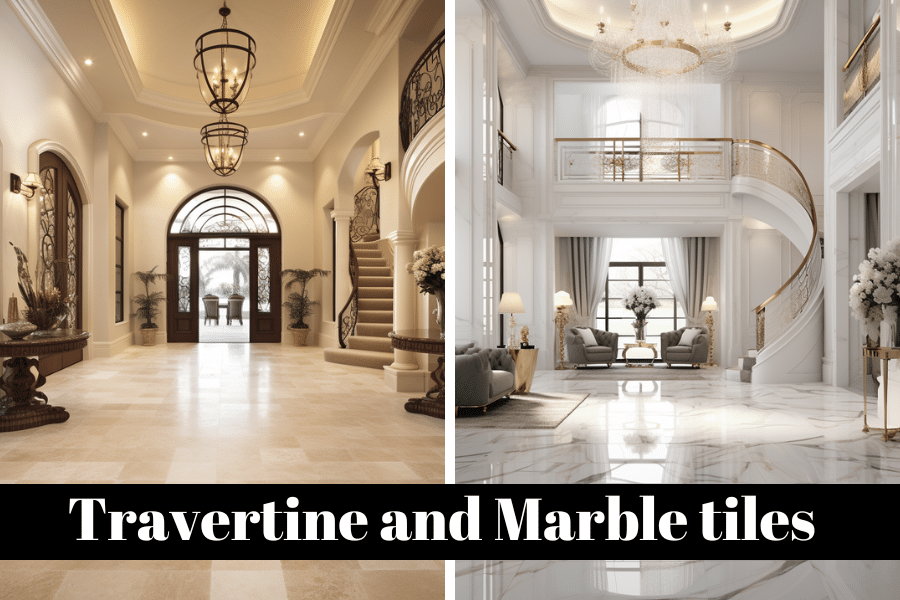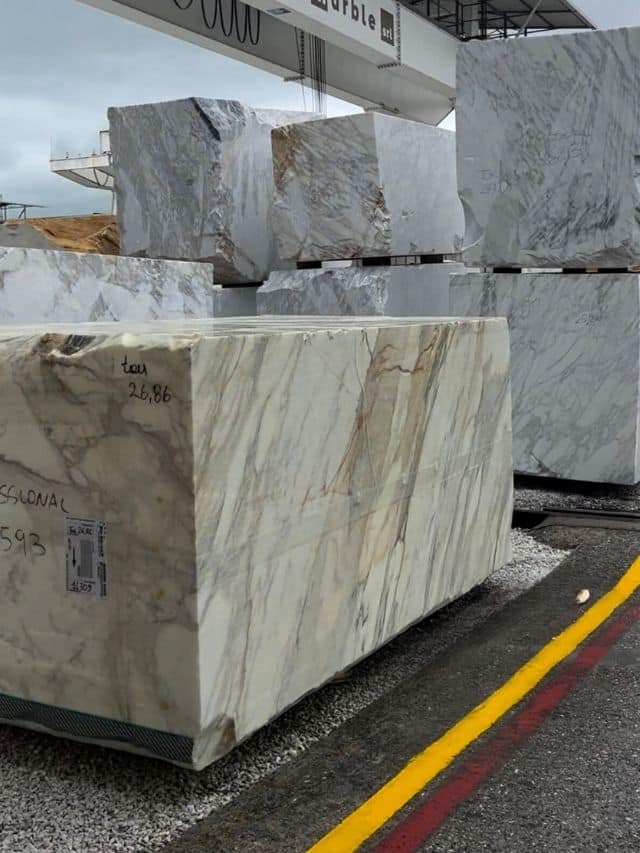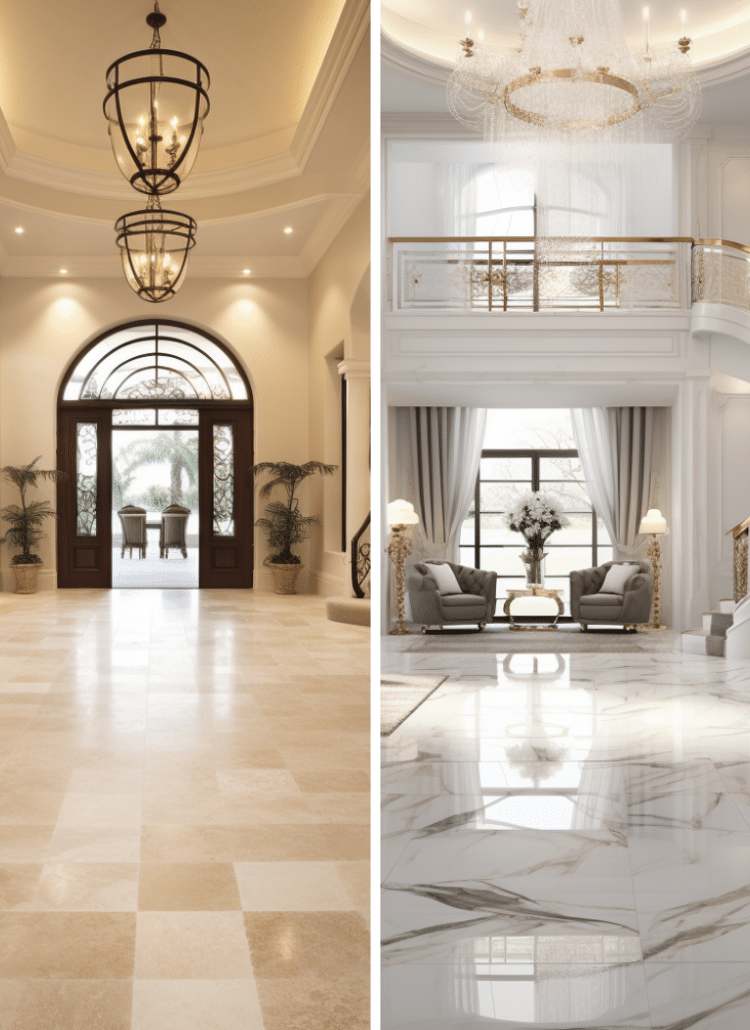
There’s something about natural stone tiles that just can’t be rivaled by synthetic stuff.
Take travertine and marble, for instance.
They’re not just pretty to look at; they’ve got a whole lot of history behind them too.
These stones have been the choice for flooring and wall decorations from the times of ancient empires right up to today’s modern houses.
It’s like they bring a piece of history and a touch of timeless beauty into any space they’re in.
In this article, I will cover everything you need to know about these two beautiful choices.
Important: On this website, I feature a select number of partners and companies that have products that could help my audience. As an Amazon associate, When you purchase something through my partner links, I might get paid for the referral at no extra cost to you. Read the full disclosure here.
JUMP TO :
Introduction to Natural Stone Tiles
Understanding Travertine Tiles
Key Differences Between Travertine and Marble
Choosing the Right Tile for Your Home
Introduction to Natural Stone Tiles

When you dive into the world of natural stone tiles, it’s like opening a treasure chest of the earth’s own artwork.
Each piece isn’t just a tile; it’s a snippet of nature’s vast palette.
We’re talking about a whole bunch of different stones here – marble, travertine, you name it.
Each type brings its unique vibe to the table, making every space something special. And the beauty of these natural materials? Unmatched.
They’re not just about looks; they add a touch of timeless elegance to your place.
Imagine having a floor or a wall that tells a story, each stone with its own history and character.
That’s the magic of choosing beautiful natural stone for your home.
Understanding Travertine Tiles

What is Travertine?
It’s this really cool type of limestone.
But not just any limestone—it’s a special form that’s come together over ages in sedimentary rocks.
Think of travertine stone as nature’s own intricate project, where layers upon layers create something truly unique.
It’s like the earth doing its own bit of art.
Limestone caves, with their majestic and natural beauty, serve as the birthplace of the remarkable travertine pavers.
Characteristics of Travertine Tiles
Now, onto what makes travertine tiles stand out.
They’re this porous stone, full of character and texture, making them an excellent choice for pretty much anywhere you want to add a touch of nature.
They’re super popular, not just because they look good but because they really bring something special to the table.
Adding travertine tiles to your space? Great addition, hands down.
Color Variations

And the colors! Travertine isn’t just stuck in one hue. We’re talking a whole range of colors, a variety that can suit any mood or style.
From light, airy feels to a warmer palette that adds a cozy vibe, travertine’s got you covered. It’s like having a rainbow of earth tones at your fingertips.
Porosity and Texture
Let’s chat about what really sets travertine apart—its porosity and texture.
Those small holes? They’re not flaws; they’re personality.
They give travertine that porous stone vibe, but with a smooth surface that feels nice underfoot. It’s this mix of texture and comfort that makes travertine tiles so appealing.
Exploring Marble Tiles

Photo Credit : Burlington Design gallery
What is Marble?
Okay, let’s dive into marble.
At its core, marble is this amazing stone that’s all about calcium carbonate.
It’s like the earth cooks it up under immense pressure and heat, transforming it into something super elegant and smooth.
Pretty cool, right?
Characteristics of Marble Tiles
When you’re looking at marble tiles, you’re looking at the epitome of elegance.
They’ve got this elegant look that can elevate any space, making it the perfect option if you’re aiming for that touch of luxury.
It’s a great way to add a sophisticated vibe to your home or any project you’ve got in mind.
Veining and Patterns

One of the standout features of marble is its veining and patterns.
Each piece has unique characteristics and its own specific look, which means no two tiles are ever the same.
It’s like each marble tile is a piece of art, giving your space a one-of-a-kind appearance.
Finish and Durability
Now, on to the finish and durability.
It’s a bit less durable compared to some other stone options, so it needs a bit of care to keep it looking its best.
But, with the right maintenance, marble can continue to dazzle in your space for years.
Key Differences Between Travertine and Marble
Appearance and Style
When you’re weighing travertine against marble, the vibe they bring to a room is like night and day.
Travertine offers you a palette that can blend into unique environments with its earthy tones, giving you a warm, welcoming feel.
It’s available in different sizes, which makes it super versatile for various spaces.
Marble, on the other hand, steps up with a broader color range, from deep, rich hues to the classic white with veining. It screams luxury and can transform a space into something out of a magazine.
RELATED POST : WHAT IS BETTER BETWEEN HONED AND POLISHED MARBLE
Durability and Maintenance

Now, let’s talk about keeping them in tip-top shape.
Travertine is pretty robust, making it suitable for everyday use, especially in high-traffic areas.
With proper care, it can withstand a lot, but remember, both travertine and marble need their share of love.
Marble requires a bit more attention, though. It’s prone to etching from acidic substances, so you’ll want to keep those lemons and vinegar away.
Regular maintenance is key for both, but if you’re looking for something a tad more forgiving, travertine might be your go-to.
Installation and Cost
When it comes to putting these tiles down, there’s a bit to consider.
Marble, with its high cost and the price tag that might make your wallet weep, is often seen as the excellent option for those looking to add an element of opulence to their space.
Travertine, while not exactly cheap, tends to be more affordable, making it a solid option for folks wanting the natural stone look without the marble price.
Installation costs can vary, but marble generally demands a bit more care (and cash) to get it just right.
Choosing the Right Tile for Your Home

Consider Your Lifestyle
When picking out tiles, think about your day-to-day life.
Got a busy home with kids or pets, or maybe a spot that sees a lot of foot traffic?
You’ll want something that stands up well in high traffic areas.
And if you love spending time outdoors or want to blend your indoor and outdoor spaces seamlessly, consider how your tiles will transition to outdoor spaces.
Don’t forget about bathroom floors, either.
They need to handle moisture well and still look good.
Aesthetic Preferences
Now, for the fun part – how do you want your space to feel?
If you’re all about that elegant look, marble might just be your jam with its beautiful choices and rich textures that can really elevate a room.
But don’t count out travertine; it’s got a rustic charm that can warm up a space beautifully.
It’s all about what speaks to you and the vibe you’re aiming for in your home.
Budget Considerations

Let’s talk numbers.
Both travertine and marble are excellent options, but they come with different price tags.
If you’re working within a tight budget but still crave that natural stone look, travertine can be the right choice.
It offers the elegance and durability you’re looking for, often at a more affordable price point.
Remember, investing in quality tiles is not just about the initial cost – it’s about choosing materials that will stand the test of time and still look great years down the line.
FREE CHECKLIST : 10 THINGS YOU NEED TO KNOW BEFORE YOU START YOUR KITCHEN REMODEL
FAQs
What is more affordable, travertine or marble?
Travertine is generally more affordable compared to marble, which comes with a high cost.
The price of marble tends to be higher due to its perceived luxury and the more intricate veining patterns that many desire.
Can travertine tiles be used outdoors?
Yes, travertine tiles are suitable for outdoor use, including pool decks and other outdoor spaces.
Their durability and aesthetic appeal make them a popular choice for enhancing exterior environments.
How do you maintain marble tiles?
Maintaining marble tiles requires regular maintenance and proper care.
It’s important to clean them gently and avoid acidic substances that can etch the surface.
Are travertine tiles durable?
Yes, travertine tiles are durable enough for everyday use, especially with proper care.
While they may be considered less durable compared to some other natural stones, they can last a long time when maintained correctly.
Which is better for bathroom flooring, travertine or marble?
Both travertine and marble are excellent choices for bathroom flooring, with each bringing its own unique beauty and characteristics.
Your preference for one over the other would depend on the specific aesthetic and maintenance level you’re looking for, making either an option a perfect option for creating a luxurious bathroom space.
Where can we use Travertine and Marble tiles ?
Travertine Tile Projects

Outdoor Patio: Travertine tiles are a popular choice for outdoor patios due to their durability and natural look that blends seamlessly with outdoor environments.
Their porous nature provides a non-slip surface, ideal for poolside areas or outdoor dining spaces.
Bathroom Remodel: For a warm, inviting bathroom, travertine tiles can be used on floors and walls.
Their natural earth tones create a spa-like atmosphere. Filling the pores in travertine tiles makes them more water-resistant, making them suitable for shower areas.
Kitchen Backsplash: Travertine tiles can bring a rustic charm to a kitchen when used as a backsplash.
Their natural variations in color and texture add depth and interest to the kitchen’s overall design, complementing both modern and traditional styles.
Marble Tile Projects
Luxury Bathroom Suite: Marble tiles are the epitome of luxury and are often used in high-end bathroom designs.
Their unique veining and rich textures make for an elegant shower surround, flooring, or countertop material, offering a timeless appeal.
Grand Entrance Hall: The use of marble tiles in an entrance hall can create a striking first impression.
With their polished finish and diverse color range, marble tiles can complement any home’s architecture, from classic to contemporary.

Kitchen Countertops: Although not a tile application, marble slabs are a perfect option for kitchen countertops, providing a durable and heat-resistant surface.
The elegance of marble can elevate the kitchen’s aesthetic, making it a focal point of the home.
What are the main differences between marble and travertine?
Marble is a metamorphic rock that forms under extreme heat and high pressures, resulting in a dense, crystalline structure with unique veining.
Travertine, a form of limestone, is a sedimentary rock that forms near mineral springs, characterized by its porous surface. Both offer a variety of finishes and colors, but their formation processes give each a distinct appearance and set of properties.
RELATED POST : MARBLE VS TRAVERTINE POOL DECK : WHICH IS BETTER ?
Which is more suitable for high temperature areas, marble or travertine?
Both marble and travertine are heat resistant, making them good choices for areas exposed to high temperatures.
However, travertine’s porous nature may require sealing to prevent staining and damage in very hot environments.
Marble’s density offers excellent heat resistance, making it a preferred choice for many when it comes to durability under extreme heat.
Can travertine and marble be used for outdoor projects, such as in a pool area?
Yes, both can be used outdoors.
Travertine pavers are particularly popular for pool areas due to their non-slip texture and heat resistance, making them comfortable under bare feet.
Marble pavers also offer a beautiful, durable option for outdoor spaces, though they may require more maintenance and can become slippery when wet.

How do travertine and marble compare in terms of finishes and colors?
Travertine and marble both come in a variety of colors and finishes, allowing for customization to fit any design aesthetic.
Travertine tends to offer a warmer palette with natural, earthy tones, while marble provides a broader range of colors with distinctive veining patterns.
The choice of finish, from polished to honed, can further customize the look and feel of these stones.
Are there specific maintenance considerations for marble and travertine tiles?
Yes, both types of stone require regular maintenance to preserve their beauty and durability.
Marble, being a metamorphic rock, is susceptible to etching from acidic substances and requires regular sealing.
Travertine, a form of limestone, is porous and also benefits from sealing to protect against stains and moisture.
Regular cleaning with a pH-neutral cleaner is recommended for both.

Which is the better option for wall tiles, marble or travertine?
The best choice depends on the aesthetic and practical requirements of the project.
Marble wall tiles offer an elegant look with rich textures and unique veining, making them a great choice for luxurious spaces.
Travertine wall tiles bring a rustic charm and warmth, ideal for creating inviting environments.
Both are of good quality and offer different products to suit various design needs.
How do travertine and marble tiles handle direct sunlight and outdoor exposure?
Travertine is highly resistant to temperature changes and does not retain heat, making it ideal for outdoor use in direct sunlight.
Marble can also withstand outdoor conditions but may require more maintenance to prevent fading and wear over time.
Both stones should be properly sealed to enhance their durability against the elements.






Leave a Reply